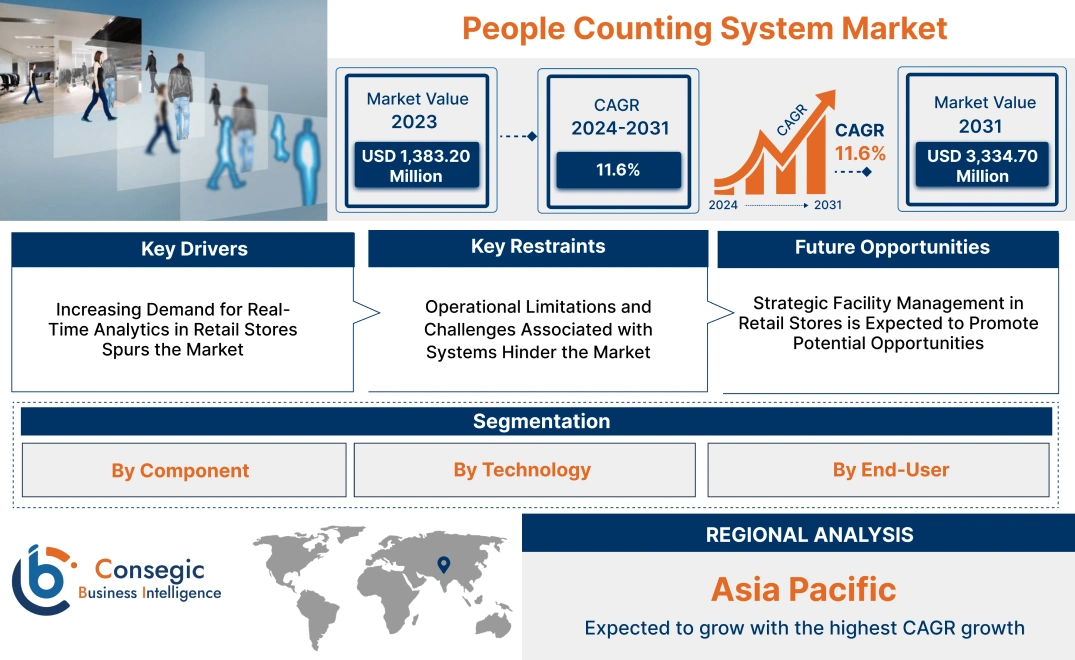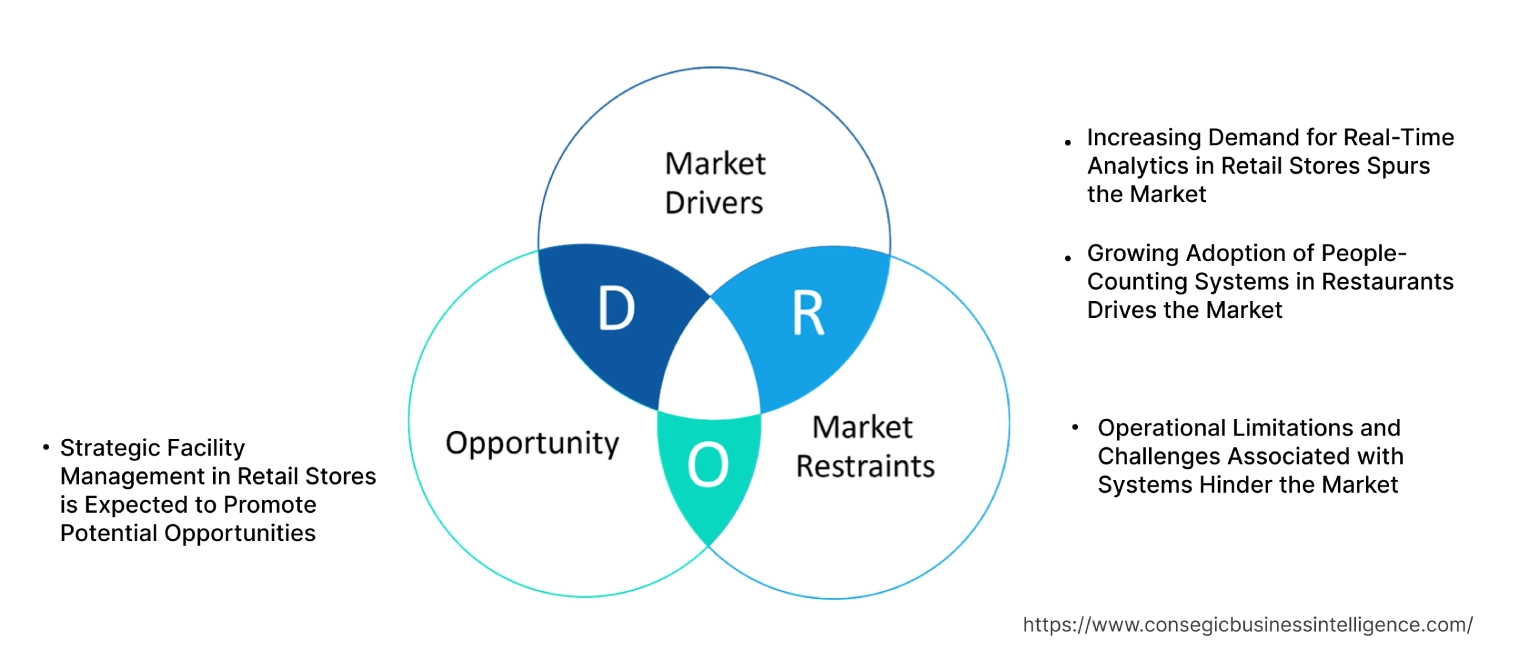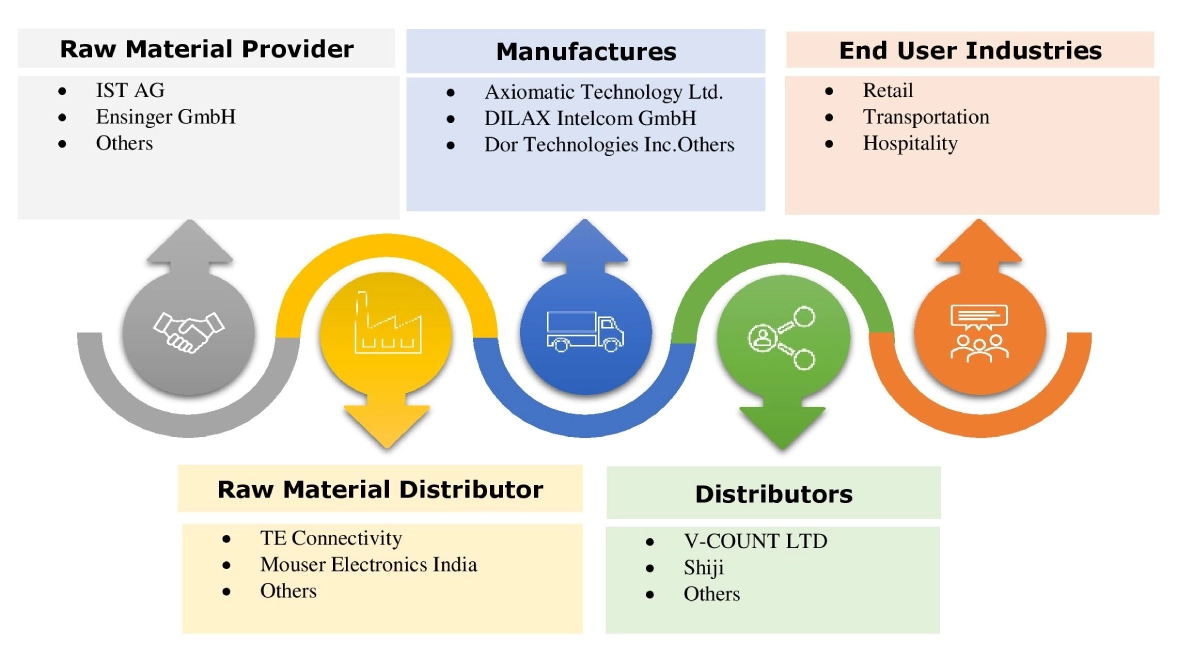- Summary
- Table Of Content
- Methodology
People Counting System Market Size:
People Counting System Market size is estimated to reach over USD 3,334.70 Million by 2031 from a value of USD 1,383.20 Million in 2023 and is projected to grow by USD 1,519.39 Million in 2024, growing at a CAGR of 11.6% from 2023 to 2031.
People Counting System Market Scope & Overview:
People counting systems use hardware sensors and software algorithms to track and count the number of individuals passing through a specific area such as doorways or zones in a building. A people counting system can also integrate with other data systems like point of sale (POS) to analyze conversion rates and customer behavior patterns. Common technologies used in people counting systems include cameras, infrared beams, thermal imaging, and others. These systems help businesses monitor foot traffic, optimize staff allocation, and manage building capacity. The primary benefits of people counting systems include real-time processing of the data, space management, improved customer service, energy savings, and enhanced security. People counting systems can be implemented in retail stores, shopping malls, airports, museums, and corporate offices. Additionally, the people counting system helps with regulatory compliance by ensuring safe occupancy limits in real-time, especially in emergencies or peak periods.
People Counting System Market Insights:
Key Drivers:
Increasing Demand for Real-Time Analytics in Retail Stores Spurs the Market
The people counting system is growing due to its potential to provide insight into consumer preferences and behavior in the retail sector. The benefits of implementing a people-counting machine in retail analytics include walk-in rate, visitor count, conversion rate, staff planning, shopper-to-staff ratio, and others. The organization's goal is to maximize the efficiency of retail spaces. The data gathered through the people counting system is used to allocate resources more effectively and redesign layouts to their full potential. By understanding space usage patterns, businesses can reduce excessive costs on heating, lighting, and cooling for underutilized areas.
- In November 2023, Dor Technologies, Inc., launched DTM (Dor Traffic Miner), a battery-powered thermal sensing device, which can be placed at the doorway of retail outlets for counting people.
Hence, the rising demand for analytics in retail stores for increasing efficiency is driving market growth.
Growing Adoption of People-Counting Systems in Restaurants Drives the Market
Restaurants use a people counting system to monitor crowds in the restaurant for occupancy limits. State and local government bodies have imposed new restrictions on restaurants to ensure they avoid overcrowding and promote social or physical distancing. Promoting social distance in restaurants requires adjusting the capacity limits and layouts for better optimization of space and enhancing customer experience by creating safe environments. By implementing people counting systems, restaurants can keep track of the number of customers to handle larger groups and improve dining experiences. Analysis from people counting systems can also help managers and owners develop strategies to increase sales in restaurants.
- In July 2020, Danish Restaurant collaborated with Dahua for an AI-powered people-counting system for calculating the real-time number of visitors to monitor occupancy limits in the restaurant.
Thus, the growing demand for monitoring people count is driving the adoption of people-counting systems in hospitality spaces such as restaurants, thereby, proliferating the people-counting system market growth.
Key Restraints :
Operational Limitations and Challenges Associated with Systems Hinder the Market
The primary limitations associated with the people counting system include privacy, maintenance, high costs, false reviews, tracking & identification, and others. Privacy concerns are a major issue, especially in camera-based systems that track individuals, raising concerns about data security and misuse. Additionally, these systems often require regular maintenance to ensure accuracy, which can be costly and time-consuming. High initial setup costs, particularly for advanced systems, pose another challenge which makes it less feasible for small businesses. Moreover, accuracy can be compromised due to difficulty in identifying and tracking people, particularly in crowded environments, this can lead to false counts and impact the effectiveness of the people-counting system.
Thus, therefore operational limitations and challenges associated with the utilization of counting systems are restricting the people counting system market demand.
Future Opportunities :
Strategic Facility Management in Retail Stores is Expected to Promote Potential Opportunities
Strategic facility management is achieved by implementing people counting systems, which identify underutilized areas and optimize space allocation. The layouts of malls and hospitals can be reconfigured for maximum efficiency using heat maps generated from foot traffic data to highlight hotspots and cold zones. Shopping malls can enhance the overall shopping experience for visitors by reallocating space based on traffic flow patterns. Facility management teams can make sure that shopping environments are safe and secure at all times by addressing maintenance issues and optimizing cleaning schedules based on real-time footfall data.
- For instance, in April 2022, Terabee unveiled the people counting L-XL range, with enhanced privacy-protected occupancy data and a real-time people counting system which are used in entrances of hotels, restaurants, and retail spaces.
Thus, the rising implementation of people counting systems for facility management at retail places is projected to promote people counting system market opportunities in upcoming years.
People Counting System Market Segmental Analysis :
By Component:
Based on the component, the market is segmented into software and hardware.
Trends in the Component:
- Hardware devices such as cameras, sensors, and others are used in people counting systems to track and monitor foot traffic.
- Software systems can be easily integrated with the existing infrastructure enabling data-driven decisions, customer behaviour insights, and efficient resource allocation.
The hardware segment accounted for the largest revenue in the year 2023.
- The ability to gather precise data required for identifying the number of visitors is crucial in expanding the market for hardware offerings.
- Hardware devices include various components such as cameras, sensors, infrared technology, and others to accurately track and monitor foot traffic.
- In September 2022, FootfallCam unveiled FootfallCam 3D Pro2, which is a people counting system. The system features advancement in accuracy, object classifications, and Wi-Fi counting.
- Thus, the rising innovation associated with hardware components is driving the people counting system market trends.
The software segment is anticipated to register a significant CAGR during the forecast period.
- The software component in the people counting market plays a crucial role in the accurate and efficient analysis of foot traffic data.
- This software system can count and track in various environments including retail, transportation, hospitality, and various others.
- People counting software enables data-driven decisions, customer behavior insights, and efficient resource allocation.
- In February 2024, Hikvision launched NVR 5.0, a video recorder with features including intuitive live view, real-time alarm and response, and faster and smarter playback.
- Therefore, the increasing advancement in software systems is anticipated to boost the people counting system market growth during the forecast period.
By Technology:
Based on the technology, the market is segmented into video-based technology, infrared beam, thermal imaging, and Others.
Trends in the technology:
- Video-based technology offers real-time information such as surveillance, occupancy, and flow patterns of crowds.
- Thermal imaging system provides benefits such as more accurate people counting, crowd density, and various other advanced insights.
The video-based technology accounted for the largest revenue of 47.49% in the year 2023 of the overall people counting system market share.
- Video cameras are used in video-based technology to detect visitors entering or leaving the detection area, which offers high accuracy during high volume slow-moving traffic.
- Organizations and businesses can make immediate decisions based on real-time information on occupancy and flow patterns for safety and managing crowds.
- For instance, in March 2020, HELLA Aglaia Mobile Vision GmbH formed a strategic partnership with VIDEOR E. Hartig GmbH to enhance its European market footprint through the German company's specialized video analysis and business intelligence capabilities.
- Thus, the rising advancements in video-based technology and real-time analysis are driving the people counting system market trends.
The thermal imaging segment is anticipated to register a significant CAGR during the forecast period.
- Increasing advancements in sensor technology for thermal imaging enables higher resolution and more accurate people counting.
- The ability to offer detailed analytics, such as crowd density and flow patterns, makes them appealing for applications that require advanced insights.
- For instance, in June 2024, Obsidian Sensors, a thermal image sensor technology developer, received an investment from Himax Technologies for the development of an advanced thermal vision solution.
- Therefore, the increasing requirements for safety and security associated with thermal imaging solutions are anticipated to boost the people counting system market growth during the forecast period.
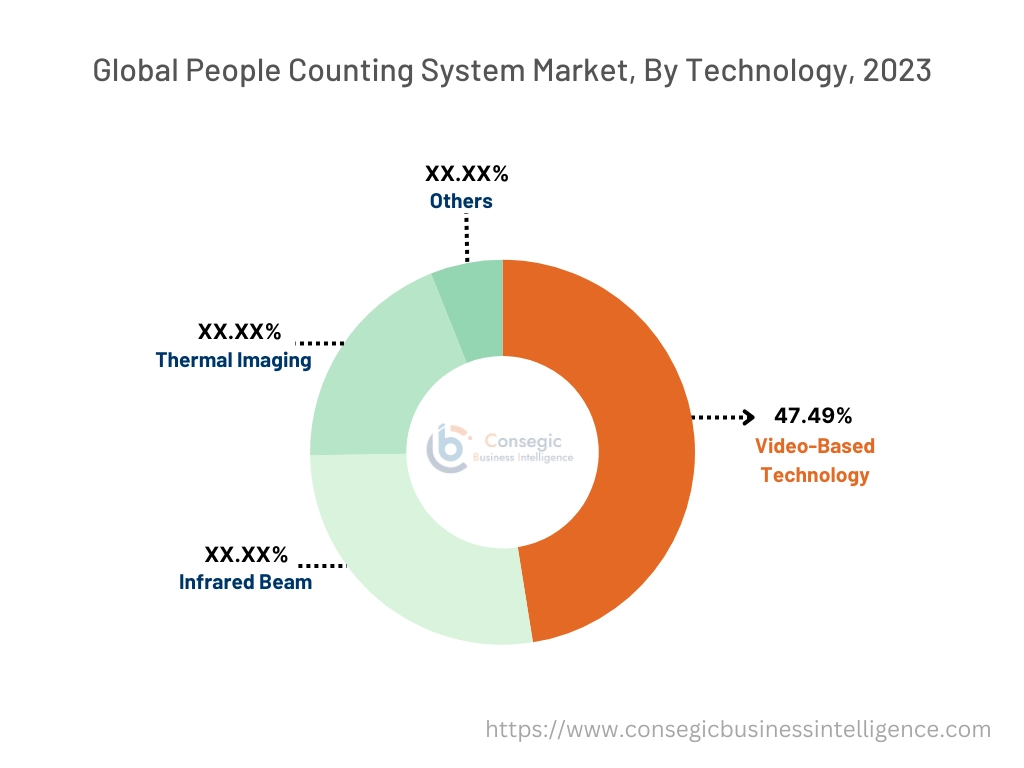
By End User:
Based on the end user, the market is segmented into retail, transportation, hospitality, and others.
Trends in the End User:
The retail sector accounted for the largest revenue share of the overall people counting system market share in 2023.
- People counting systems in retail environments help in tracking visitors, monitoring peak shopping hours, and evaluating the effectiveness of peak marketing hours.
- In the retail sector, the people counting system offers various benefits such as crowd density, flow patterns, walk-in rate, enhanced space allocation, and others.
- In April 2022, DELPOT launched DELPOT STRIDE, a people-counting system product, which offers enhanced customer experience, data-driven decisions, performance measurement, and improved security.
- Thus, as per the segmental trends analysis, the growing retail sector is driving the people counting system market expansion.
The hospitality sector is anticipated to register a significant CAGR during the forecast period.
- Hotels, restaurants, event venues, and other hospitality establishments use people-counting solutions to monitor visitor flow, manage occupancy levels, and improve service delivery.
- This data helps optimize staffing levels, manage space utilization, ensure compliance with safety regulations, and improve guest services.
- According to the Investment Information and Credit Rating Agency (ICRA), Indian premium hotel occupancy is expected to increase because of rising domestic travel.
- Therefore, the growing hospitality sector is anticipated to boost people counting system market expansion during the forecast period.
Regional Analysis:
The regions covered are North America, Europe, Asia Pacific, the Middle East and Africa, and Latin America.
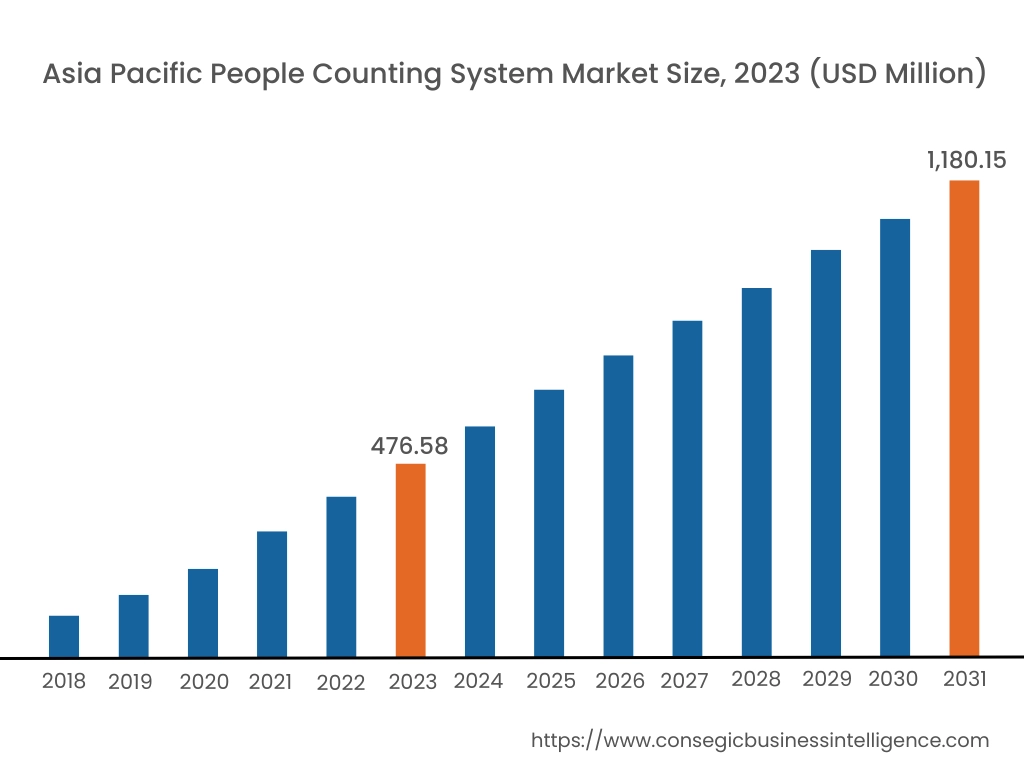
Asia Pacific region was valued at USD 476.58 Million in 2023. Out of this, China accounted for the maximum revenue share of 33.5%. Moreover, it is projected to grow by USD 524.69 Million in 2024 and reach over USD 1,180.15 Million by 2031.
The Asia Pacific region's growing pace of urbanization and development offers lucrative growth prospects for the market. Additionally, the rising number of shopping malls, hotels, cafes, and restaurants is contributing to the market in the Asia-Pacific region.
- For instance, in July 2024, Taj launched a new hotel called Taj City Center in Patna, Bihar. As the rising number of hotels increases the adoption of people-counting systems will increase simultaneously.
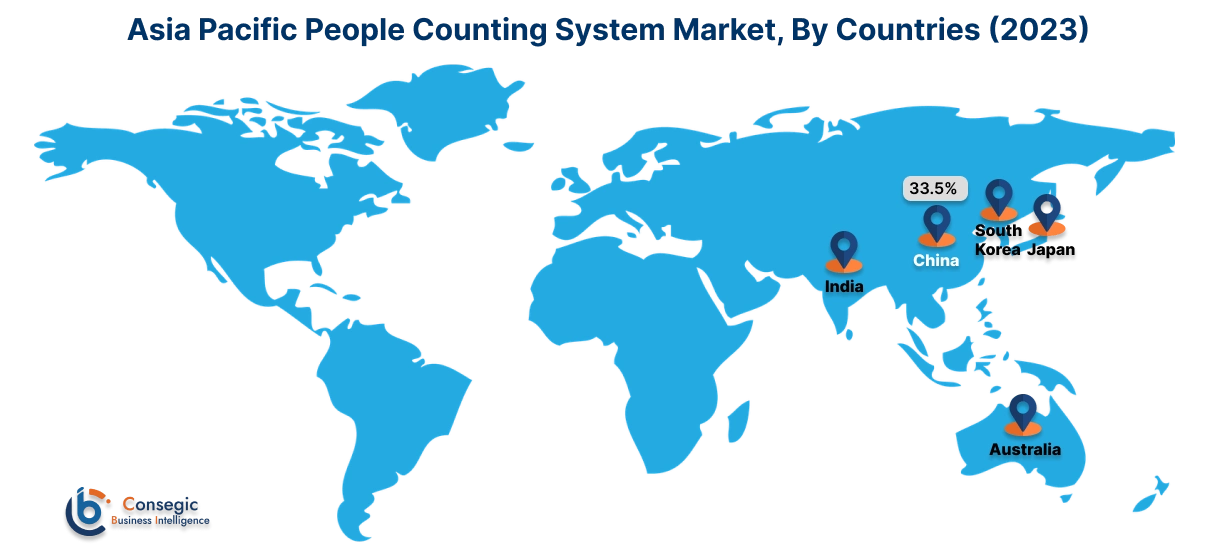
North America is estimated to reach over USD 1,036.76 Million by 2031 from a value of USD 428.90 Million in 2023. The market growth for people counting systems in North America is mainly driven by their increasing deployment in retail sectors including cafes, shopping malls, and others.
- For instance, in September 2023, Xovis launched the AERO company's passenger flow service with a people counting system that improves accuracy and uses real-time data.
Furthermore, factors including increasing footfall in retail outlets in the region are projected to drive the people counting system market demand in North America during the forecast period.
As per the people counting system market analysis, Europe is anticipated to witness substantial growth that is backed by the increasing adoption of people counting systems in commercial and industrial buildings to offer advanced occupancy and compliance-related applications. The regional trends depict that the Middle East, Africa, and Latin America are expected to grow at a considerable rate due to increasing investments in the development of commercial and industrial buildings in countries such as Brazil, UAE, and others.
Top Key Players & Market Share Insights:
The people counting system market is highly competitive with major players providing products to the national and international markets. Key players are adopting several strategies in research and development (R&D), product innovation, and end-user launches to hold a strong position in the market. Key players in the people counting system industry include-
- Axiomatic Technology Ltd. (UK)
- DILAX Intelcom GmbH (Germany)
- FootfallCam (UK)
- Gigabyte Technology Co. Ltd. (Taiwan)
- Hangzhou Hikvision Digital Technology Co. Ltd. (China)
- Dor Technologies Inc. (US)
- HELLA GmbH and Co. KGaA (Germany)
- iris GmbH infrared and intelligent sensors (Germany)
- Johnson Controls International Plc (Ireland)
- Koninklijke Philips N.V. (Netherlands)
People Counting System Market Report Insights :
| Report Attributes | Report Details |
| Study Timeline | 2018-2031 |
| Market Size in 2031 | USD 3,334.70 Million |
| CAGR (2024-2031) | 11.6% |
| By Component |
|
| By Technology |
|
| By End-User |
|
| By Region |
|
| Key Players |
|
| North America | U.S. Canada Mexico |
| Europe | U.K. Germany France Spain Italy Russia Benelux Rest of Europe |
| APAC | China South Korea Japan India Australia ASEAN Rest of Asia-Pacific |
| Middle East and Africa | GCC Turkey South Africa Rest of MEA |
| LATAM | Brazil Argentina Chile Rest of LATAM |
| Report Coverage |
|
Key Questions Answered in the Report
How big is the People counting system market? +
People Counting System Market size is estimated to reach over USD 3,334.70 Million by 2031 from a value of USD 1,383.20 Million in 2023 and is projected to grow by USD 1,519.39 Million in 2024, growing at a CAGR of 11.6% from 2023 to 2031.
Which is the fastest-growing region in the people counting system market? +
Asia-Pacific is the region experiencing the most rapid growth in the people counting system market.
What specific segmentation details are covered in the people counting system report? +
The people counting system report includes specific segmentation details for component, type, end user, and region.
Who are the major players in the people counting system market? +
The key participants in the people counting system market are Axiomatic Technology Ltd. (UK), DILAX Intelcom GmbH (Germany), Dor Technologies Inc. (US), FootfallCam (UK), Gigabyte Technology Co. Ltd. (Taiwan) Hangzhou Hikvision Digital Technology Co. Ltd. (China), HELLA GmbH and Co. KGaA (Germany), Iris GmbH Infrared and Intelligent Sensors (Germany), Johnson Controls International Plc (Ireland), Koninklijke Philips N.V. (Netherlands).
